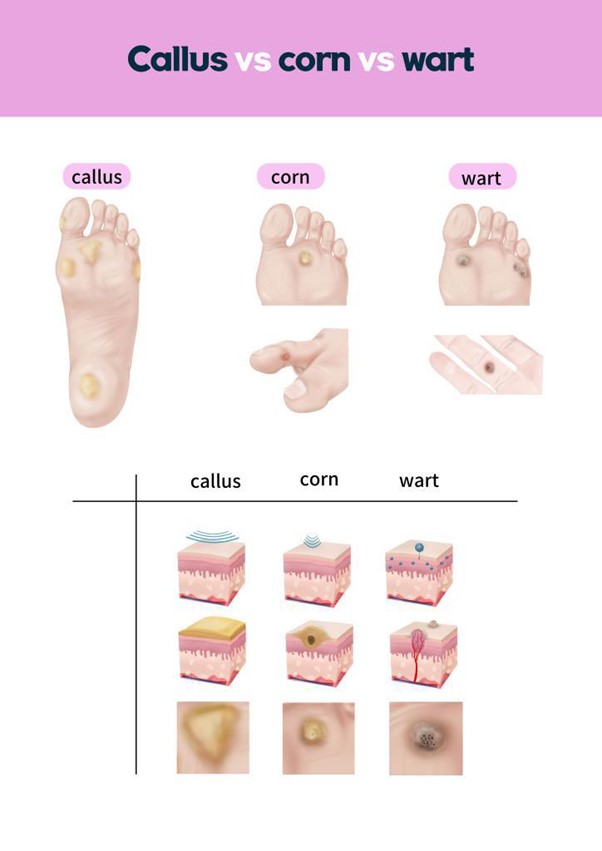A nurse is teaching an older adult client who has type 2 diabetes mellitus about how to care for corns and calluses on her toes. Which of the following statements by the client indicates an understanding of the teaching?
"I should soak my feet in warm water daily to soften corns and calluses."
"I can place an oval corn pad over toes that have corn as long as I remove the pad weekly."
"I should use an over-the-counter liquid medication to remove corns."
"I can apply lotion to soften calluses as long as I don't put lotion between my toes."
The Correct Answer is D
Choice A reason:
Soaking feet in warm water daily is not recommended for individuals with diabetes, as it can increase the risk of skin maceration and infection. People with diabetes should be cautious about foot care practices that involve prolonged moisture exposure.
Choice B reason:
Placing an oval corn pad over the toes with corn and removing it weekly may not be the best approach, as it can increase pressure on the area and potentially cause further skin irritation.
Choice C reason:
Using over-the-counter liquid medication to remove corns is not recommended for individuals with diabetes, as it can cause skin irritation, burns, or infection. It's important for individuals with diabetes to seek professional guidance for proper foot care.
Choice D reason:
"I can apply lotion to soften calluses as long as I don't put lotion between my toes." This is the correct statement. This statement indicates an understanding of proper care for corns and calluses. Applying lotion to soften calluses can help reduce discomfort, but it's important to avoid putting lotion between the toes to prevent excess moisture build-up that could lead to skin breakdown or infection.

Nursing Test Bank
Naxlex Comprehensive Predictor Exams
Related Questions
Correct Answer is D
Explanation
Choice A reason:
Attaching the drainage bag to the side rails of the bed can create tension on the catheter and increase the risk of trauma or dislodgment.
Choice B reason:
Emptying the drainage bag when it is three-quarters full is appropriate to prevent the bag from becoming too heavy and pulling on the catheter. However, this is a practice for maintaining bag weight, not part of the overall care plan.
Choice C reason:
Taping the catheter to the lower abdomen is not recommended. Taping the catheter can cause irritation, tension, and skin breakdown, increasing the risk of infection and trauma to the urethra. The catheter should be secured to the thigh using a catheter securement device if necessary.
Choice D reason:
Keeping the drainage bag below the level of the bladder is the correct recommendation. When caring for a client with an indwelling urinary catheter, it is important to maintain proper catheter and drainage bag positioning to prevent complications. Keeping the drainage bag below the level of the bladder helps promote the free flow of urine, prevent reflux of urine into the bladder, and minimize the risk of urinary tract infections.
Correct Answer is A
Explanation
Choice A reason:
"New dressing applied as prescribed; no drainage on old dressing. “This entry provides clear and concise information about the action taken (applying a new dressing as prescribed) and the assessment of the old dressing (no drainage present). It accurately reflects the dressing change process and the status of the wound.
Choice B reason:
"Client premedicated with MSO, sub-prior to dressing change." This entry is incorrect because it provides information about the client being premedicated, but it doesn't specifically address the dressing change or the pressure injury.
Choice C reason:
"The wound seems clean and does not appear to be infected." While this entry provides an assessment of the wound's cleanliness and potential infection, it lacks specific details about the dressing change itself.
Choice D reason:
"No changes noted to the wound from previous nursing notes." This entry focuses on comparing the wound to previous notes but doesn't provide information about the current dressing change or assessment.
Whether you are a student looking to ace your exams or a practicing nurse seeking to enhance your expertise , our nursing education contents will empower you with the confidence and competence to make a difference in the lives of patients and become a respected leader in the healthcare field.
Visit Naxlex, invest in your future and unlock endless possibilities with our unparalleled nursing education contents today
Report Wrong Answer on the Current Question
Do you disagree with the answer? If yes, what is your expected answer? Explain.
Kindly be descriptive with the issue you are facing.
